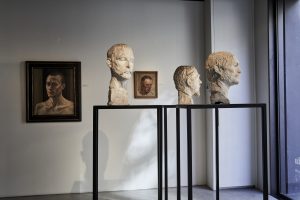“Creativity has no secrets; it is personal experience, it is training, it is work. Art is in what surrounds you, and is not produced in the middle of nowhere, it is in life, in everyday life.”
Biografia
Internationally recognized painter and engraver, Josep Guinovart i Bertran (Barcelona 1927–2007) is one of the most personal voices on the Spanish scene. At first linked to the Dau al Set group, and later one of the founders of the Tahull group, together with Jaume Muxart, Antoni Tapies and Joan Josep Tartas, during the first years of his activity he made mural paintings, theater decorations, posters and illustrations.
Starting from a first figurative stage, Guinovart's work evolves with a theme of a social nature and with a tendency towards muralism. Abstract currents and informalism open up new perspectives in the aesthetics of his painting. In 1957, using other resources such as the incorporation of objects and the free manipulation of matter, Guinovart began a series of experiments close to assemblage or collage, based on drums, burned wood, waste items, boxes, coverings, etc. In the 60s he developed his work towards an expressive content and social and political denunciation. Between his plastic expression and his vital environment, made up of nature, the countryside and the earth, a lively dialogue is generated, manifested through symbols that are part of a subjective poetics.
He studied at the Lonja school and at the Fomento de Artes Decorativas de Barcelona, after having worked from 1941 as a painter of murals, theater scenographer and illustrator for the magazine of the Dau al Set group. In 1948 he had his first exhibition. The initial stage of his career is marked by two lines: one realistic, naive and popular, and the other naturalistic and of educated aspiration. In addition, that period is marked by the influences of artists such as Nonell and Gimeno.
In 1953 he won a scholarship from the French Institute and studied in the French capital for a few months. The scholarship allows him to travel to Paris, and see original works by Matisse and Cezanne, among others, and movements such as cubism. Back in Barcelona, his work evolved towards abstraction, the decomposition of the figure and informalism, experimenting with a style close to assemblage and collage.
A trip to Mexico and Cuba in 1972 brought the artist into contact with exotic cultures and new social environments for a Western man, influencing the works of this phase as much as later ones. His matured work is characterized by the representation of his inner world with a free language but always in contact with reality.
Guinovart has been awarded the National Prize for Plastic Arts by the Spanish government in 1982 and by the Department of Culture of the Generalitat de Catalunya in 1990. Since 1994 in Agramunt, the city where the artist's family lived during the Civil War and population of birth of his mother, he dedicated the Espai Guinovart foundation and museum to the painter.




